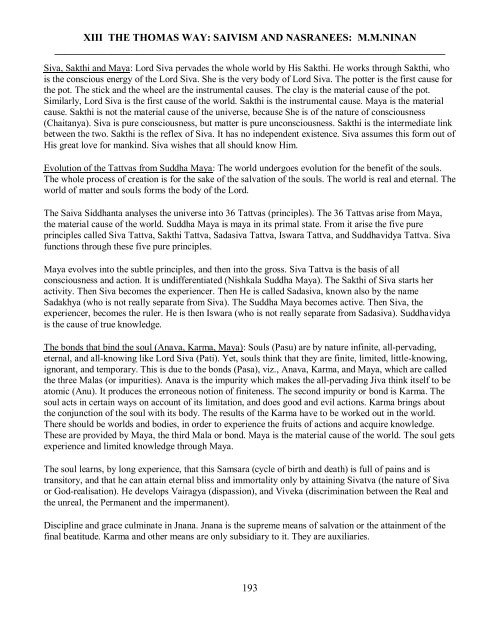Acts of Apostle Thomas
Create successful ePaper yourself
Turn your PDF publications into a flip-book with our unique Google optimized e-Paper software.
XIII THE THOMAS WAY: SAIVISM AND NASRANEES: M.M.NINAN<br />
___________________________________________________________________________<br />
Siva, Sakthi and Maya: Lord Siva pervades the whole world by His Sakthi. He works through Sakthi, who<br />
is the conscious energy <strong>of</strong> the Lord Siva. She is the very body <strong>of</strong> Lord Siva. The potter is the first cause for<br />
the pot. The stick and the wheel are the instrumental causes. The clay is the material cause <strong>of</strong> the pot.<br />
Similarly, Lord Siva is the first cause <strong>of</strong> the world. Sakthi is the instrumental cause. Maya is the material<br />
cause. Sakthi is not the material cause <strong>of</strong> the universe, because She is <strong>of</strong> the nature <strong>of</strong> consciousness<br />
(Chaitanya). Siva is pure consciousness, but matter is pure unconsciousness. Sakthi is the intermediate link<br />
between the two. Sakthi is the reflex <strong>of</strong> Siva. It has no independent existence. Siva assumes this form out <strong>of</strong><br />
His great love for mankind. Siva wishes that all should know Him.<br />
Evolution <strong>of</strong> the Tattvas from Suddha Maya: The world undergoes evolution for the benefit <strong>of</strong> the souls.<br />
The whole process <strong>of</strong> creation is for the sake <strong>of</strong> the salvation <strong>of</strong> the souls. The world is real and eternal. The<br />
world <strong>of</strong> matter and souls forms the body <strong>of</strong> the Lord.<br />
The Saiva Siddhanta analyses the universe into 36 Tattvas (principles). The 36 Tattvas arise from Maya,<br />
the material cause <strong>of</strong> the world. Suddha Maya is maya in its primal state. From it arise the five pure<br />
principles called Siva Tattva, Sakthi Tattva, Sadasiva Tattva, Iswara Tattva, and Suddhavidya Tattva. Siva<br />
functions through these five pure principles.<br />
Maya evolves into the subtle principles, and then into the gross. Siva Tattva is the basis <strong>of</strong> all<br />
consciousness and action. It is undifferentiated (Nishkala Suddha Maya). The Sakthi <strong>of</strong> Siva starts her<br />
activity. Then Siva becomes the experiencer. Then He is called Sadasiva, known also by the name<br />
Sadakhya (who is not really separate from Siva). The Suddha Maya becomes active. Then Siva, the<br />
experiencer, becomes the ruler. He is then Iswara (who is not really separate from Sadasiva). Suddhavidya<br />
is the cause <strong>of</strong> true knowledge.<br />
The bonds that bind the soul (Anava, Karma, Maya): Souls (Pasu) are by nature infinite, all-pervading,<br />
eternal, and all-knowing like Lord Siva (Pati). Yet, souls think that they are finite, limited, little-knowing,<br />
ignorant, and temporary. This is due to the bonds (Pasa), viz., Anava, Karma, and Maya, which are called<br />
the three Malas (or impurities). Anava is the impurity which makes the all-pervading Jiva think itself to be<br />
atomic (Anu). It produces the erroneous notion <strong>of</strong> finiteness. The second impurity or bond is Karma. The<br />
soul acts in certain ways on account <strong>of</strong> its limitation, and does good and evil actions. Karma brings about<br />
the conjunction <strong>of</strong> the soul with its body. The results <strong>of</strong> the Karma have to be worked out in the world.<br />
There should be worlds and bodies, in order to experience the fruits <strong>of</strong> actions and acquire knowledge.<br />
These are provided by Maya, the third Mala or bond. Maya is the material cause <strong>of</strong> the world. The soul gets<br />
experience and limited knowledge through Maya.<br />
The soul learns, by long experience, that this Samsara (cycle <strong>of</strong> birth and death) is full <strong>of</strong> pains and is<br />
transitory, and that he can attain eternal bliss and immortality only by attaining Sivatva (the nature <strong>of</strong> Siva<br />
or God-realisation). He develops Vairagya (dispassion), and Viveka (discrimination between the Real and<br />
the unreal, the Permanent and the impermanent).<br />
Discipline and grace culminate in Jnana. Jnana is the supreme means <strong>of</strong> salvation or the attainment <strong>of</strong> the<br />
final beatitude. Karma and other means are only subsidiary to it. They are auxiliaries.<br />
193


















